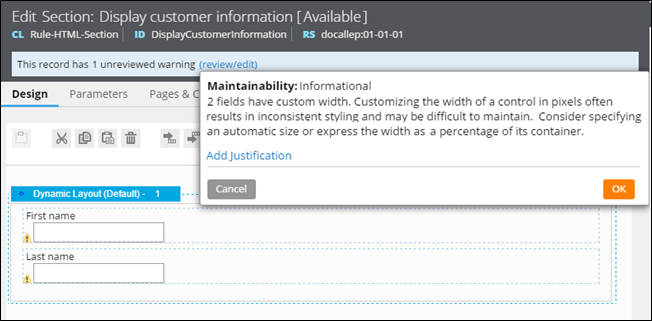Improved adaptive model accuracy
Valid from Pega Version 7.1.7
Enhancements have been made in the grouping scores method that is used to create the adaptive model outcome profile (also known as: classifier). Because scores form the base for calculating propensities, these changes make models more accurate. The enhanced grouping scores method is available with any new model generated in Pega 7.1.7 and does not require any changes to existing adaptive model rules or adaptive model components. For more information on adaptive models, see About Adaptive Model rules.
In-memory Adaptive Analytics Manager process
Valid from Pega Version 7.1.7
The new internal Adaptive Analytics Manager (ADM) process running in PRPC makes it possible to use adaptive analytics without the availability of the external ADM server. Although not a replacement for the external ADM server, it streamlines the design and development of applications making use of adaptive analytics. For more information on the configuration that allows your application to use the internal ADM process, see the Infrastructure Services landing page.
Delayed adaptive learning
Valid from Pega Version 7.1.7
Data flows, a new rule type in Pega 7.1.7, allow you to store adaptive inputs and interaction results for a given period of time when running a strategy. This makes it possible to capture and learn from responses at a later date. For more information on data flow design for delayed learning, see Data Flow rule form - Completing the Data Flow tab.
Decision data stores
Valid from Pega Version 7.1.7
Decision Management in Pega 7.1.7 introduces two new concepts to manage data: decision data stores, and Data Nodes (DNodes). Horizontally scalable, and supported by DNodes, decision data stores take data from different sources, and make it available for real time and batch processing. This infrastructure is managed through the DNode Cluster Management landing page.
Manage data from different sources using data sets
Valid from Pega Version 7.1.7
Data sets define collections of records, allowing you to set up instances that make use of data abstraction to represent information stored in different sources and formats. This new rule type introduces the ability to manage data in database tables, decision data stores, and Visual Business Director data sources. Standard Interaction History and Adaptive Manager data sets manage interaction results and adaptive model data. The DataSet-Execute method supports data management operations on records that are defined by the data set. For more information on this new rule type, see About Data Set rules.
Data flow orchestration
Valid from Pega Version 7.1.7
Data flows provide a pattern-guided design experience to orchestrate, combine and sequence data based on a set of instructions from source to destination. You can run and manage data flows using the Data Flows landing page. For more information on this new rule type, see About Data Flow rules.
Maintainable warning, error, and tip information
Valid from Pega Version 7.1.7
Use the redesigned Message form to define warning, error, tip, or custom category information in your application. Encapsulating these details in a message makes them easier to maintain and review. After you have created a new warning, you can quickly add it to a rule in your application using the new pxAddGuardrailMessage function.
For more information on the tabs and available fields on the Message form, see About Message rules.
Easy-to-browse warning catalog
Valid from Pega Version 7.1.7
All Pega 7 warnings have been converted to Rule-Message instances, each with a clearly written, risk mitigation path. This allows you to use the Records Explorer to browse through all warnings in the system, organized by category. To view warnings associated with specific rules in your application, refer to the Application Guardrails landing page.
Communicate guardrail compliance with the pxAddGuardrailMessage function
Valid from Pega Version 7.1.7
Now that guardrail warnings are in the model, you can easily attach them to rules in your application using the new pxAddGuardrailMessage function. Call this function to display warnings to your application users when they do not adhere to guardrails or best practices. Adopting this function in your application allows you to:
- Use localizable Rule-Message instances that are categorized by severity and application impact.
- Add dynamic warnings to your rules by passing parameters to a standard or custom message.
- Stop using and maintaining hard coded strings.

Design time view of warning messages

Run time view of an attached warning
This function supersedes the addWarning function, which has been deprecated. You can continue to use the CheckForCustomWarnings extension point, but it is recommended that you convert hard coded strings to messages and migrate any dependencies on addWarning to pxAddGuardrailMessage.
For more information on message attaching techniques, see Working with messages.
Track custom details with extensible messages
Valid from Pega Version 7.1.7
The customizable Message form gives you the freedom to expand upon default categories, store application specific data in a message, and enforce specialized validation. Leveraging these options makes it easier for you to identify a specific variety of message and incorporate new properties into your existing message processing logic.
For more details on which rules to override, see How to extend the Message form.

